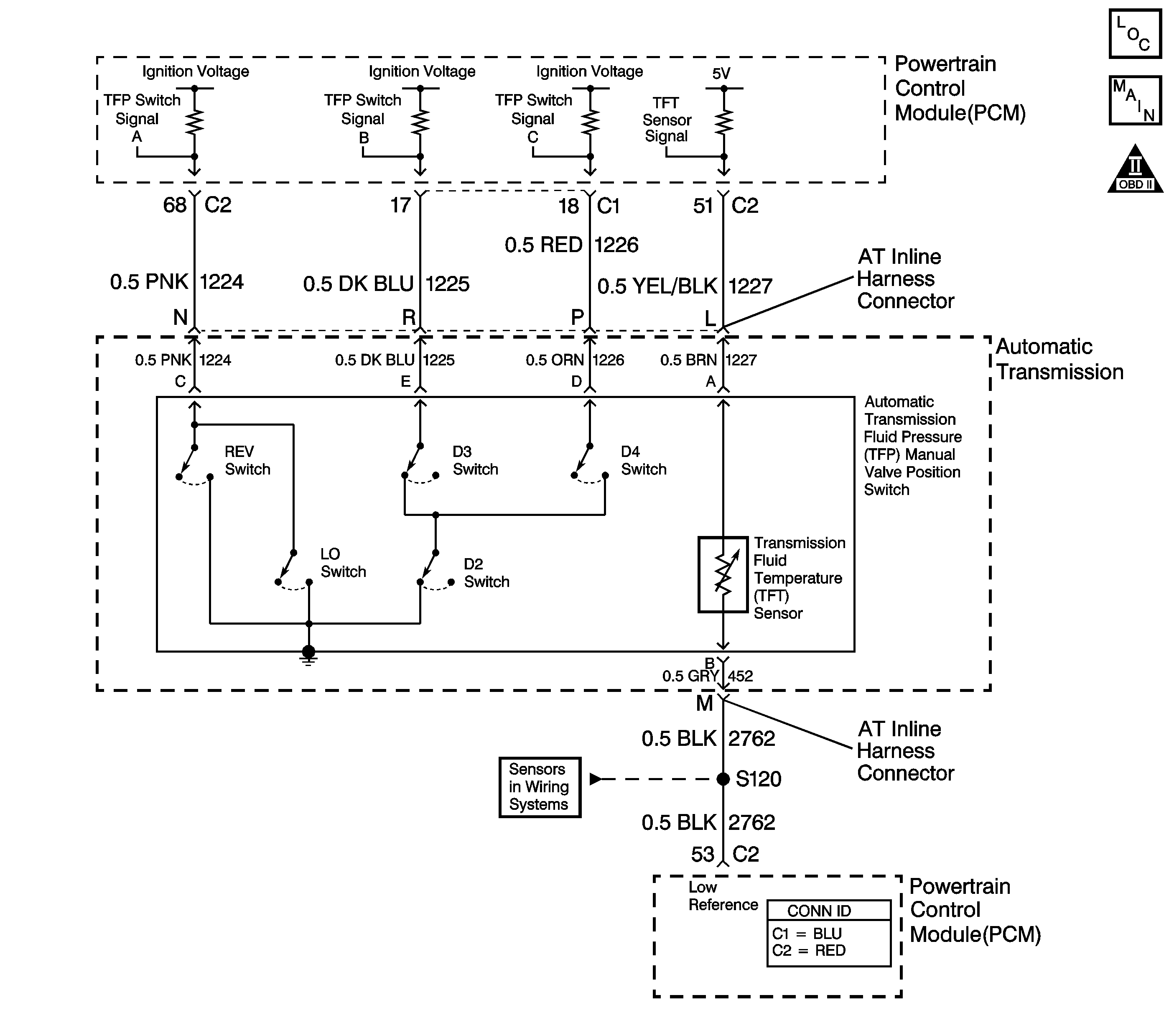
Circuit Description
The automatic transmission fluid temperature (TFT) sensor is part of the automatic transmission fluid pressure (TFP) manual valve position switch. The TFT sensor is a resistor, or thermistor, which changes value based on temperature. The sensor has a negative-temperature coefficient. This means that as the temperature increases, the resistance decreases, and as the temperature decreases, the resistance increases. The powertrain control module (PCM) supplies a 5-volt reference signal to the sensor on the TFT sensor signal circuit and measures the voltage drop in the circuit. When the transmission fluid is cold, the sensor resistance is high and the PCM detects high signal voltage. As the fluid temperature warms to a normal operating temperature, the resistance becomes less and the signal voltage decreases. The PCM uses this information to control shift quality and torque converter clutch apply.
When the PCM detects a continuous open or short to power in the TFT signal circuit or the TFT sensor, then DTC P0713 sets. DTC P0713 is a type C DTC.
Conditions for Running the DTC
| • | The system voltage is 10-18 volts. |
| • | The ignition is ON. |
Conditions for Setting the DTC
The TFT sensor indicates a signal voltage greater than 4.92 volts for 400 seconds (6.8 minutes).
Action Taken When the DTC Sets
| • | The PCM does not illuminate the malfunction indicator lamp (MIL). |
| • | The PCM calculates a default transmission fluid temperature based on engine coolant temperature, intake air temperature and engine run time. |
| • | The PCM records the operating conditions when the Conditions for Setting the DTC are met. The PCM stores this information as Failure Records. |
Conditions for Clearing the DTC
| • | A scan tool can clear the DTC. |
| • | The PCM clears the DTC from PCM history if the vehicle completes 40 warm-up cycles without a non-emission-related diagnostic fault occurring. |
| • | The PCM cancels the DTC default actions when the fault no longer exists and/or the ignition switch is OFF long enough in order to power down the PCM. |
Test Description
The numbers below refer to the step numbers on the diagnostic table.
-
This step verifies a condition in the TFT sensor circuit.
-
This step simulates a TFT sensor DTC P0712. If the PCM recognizes low signal voltage, high temperature, the PCM and wiring are functioning normally.
-
This step tests the TFT sensor and automatic transmission (AT) wiring harness assembly.
Step | Action | Value(s) | Yes | No |
|---|---|---|---|---|
1 | Did you perform the Powertrain Diagnostic System Check? | -- | Go to Step 2 | Go to Diagnostic System Check - Engine Controls in Engine Controls |
2 | Inspect for correct transmission fluid level. Refer to Transmission Fluid Check . Did you perform the fluid checking procedure? | -- | Go to Step 3 | Go to Transmission Fluid Check |
Important: Before clearing the DTC, use the scan tool in order to record the Failure Records. Using the Clear Info function erases the Failure Records from the PCM. Does the scan tool displays a TFT Sensor signal voltage less than the specified value? | 4.92 V | Go to Intermittent Conditions in Engine Controls | Go to Step 4 | |
Refer to Automatic Transmission Inline Harness Connector End View . Does the TFT Sensor signal voltage drop to less than the specified value? | 0.2 V | Go to Step 5 | Go to Step 8 | |
Refer to Automatic Transmission Inline Harness Connector End View . Does the resistance measure within the specified range? | 3088-3942 Ohms at 20°C (68°F) 159-198 Ohms at 100°C (212°F) | Go to Intermittent Conditions in Engine Controls | Go to Step 6 | |
6 | Test the signal circuit (CKT 1227) and the low reference circuit (CKT 452) of the TFT sensor for an open between the AT inline 20-way connector and the TFT sensor. Refer to Circuit Testing in Wiring Systems. Did you find an open condition? | -- | Go to Step 10 | Go to Step 7 |
7 | Replace the TFT sensor, this sensor is part of the TFP manual valve position switch. Refer to Valve Body and Pressure Switch Replacement . Did you complete the replacement? | -- | Go to Step 12 | -- |
8 | Test the signal circuit (CKT 1227) of the TFT sensor for an open or short to power between the PCM connector C2 and the AT inline 20-way connector. Refer to Circuit Testing and Wiring Repairs in Wiring Systems. Did you find and correct the condition? | -- | Go to Step 12 | Go to Step 9 |
9 | Test the low reference circuit (CKT 407) of the TFT sensor for an open. Refer to Circuit Testing and Wiring Repairs in Wiring Systems. Did you find and correct the condition? | -- | Go to Step 12 | Go to Step 11 |
10 | Replace the AT wiring harness assembly. Refer to Valve Body and Pressure Switch Replacement . Did you complete the replacement? | -- | Go to Step 12 | -- |
11 | Replace the PCM. Refer to Powertrain Control Module Replacement in Engine Controls. Did you complete the replacement? | -- | Go to Step 12 | -- |
12 | Perform the following procedure in order to verify the repair:
Has the test run and passed? | -- | System OK | Go to Step 1 |
